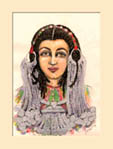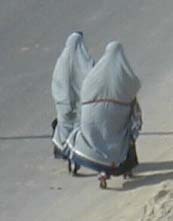 |
Culture.

|

|
 |
Siwan
Medicine
There are
many Siwans who are skilled in homeopathic medicine and who
offer treatment for free. Any kind of work that is for the
community good is performed for free in Siwa, and most healers
will refuse money unless healing is their only form of
livelihood. Men and women healers specialize in mixing
medicines, setting broken bones, Qur’anic healing and
midwivery.
Bone Setting – The Way of ‘Agl’s Healing:
The ‘Agl family (“Nan ‘Agl”) is famous throughout the
oasis for setting broken bones and dislocated joints for free,
and their skill is handed down from one generation to the
next. No x-rays are used – they locate the fracture by
feeling with their hands and use humor as an anesthesia. The
healer massages the broken limb and tugs on its joints until
he figures out the problem, all the while chatting and joking
to distract the patient. While the patient is laughing, the
healer tugs the bones and sets them in the right place. Then
he sandwiches the broken limb between two palm branch splints
and bandages them together. If the joint is dislocated, the
healer rubs it with white sheep meat and resets it. The
children of the family learn bone setting from their father.
If they don’t understand how the bone fits, their father
squeezes their ears with palm seeds to stress his
point.
Blood Clots:
The ‘Agl family also treat blood clots by pricking them with
pins and rubbing the area with salt. This method is known as
“Adegee”. If there is still massing swelling, they will
make small hatch marks with a razor blade to release the blood
(“Adoqee el Moos”).
Back Pains & Headaches:
Haj Hosni performs “tabernant,” which is similar
to cupping. Small sacks of salt, the tops twisted into wicks,
are placed on the sore back. The wicks are lit and glasses
placed over them, creating a suction. When the glasses are
removed, the skin underneath swells, and the healer cuts tiny
hatch marks with a razor blade to remove the blood. Something
similar is done for severe chronic headaches, only a ram’s
horn is used for the suction rather than a glass and salt
sack. A small area of the head is shaved, and the hollow
ram’s horn is cupped over it. The healer sucks through the
narrow end of the horn, raising the skin. Small hatch marks
are cut into the skin, and the skin is suctioned again.
Rheumatism:
Sandbaths taken at the sand dunes near Dakrur
Mountain are said to be very good for rheumatism, and there
are some who travel to Siwa every summer for the curative
power of the sandbaths alone. The pits are dug in the dry sun
and must be ready before noon when the sun is hottest. The
bather is buried up to the neck, naked, in hot sand, with an
umbrella to protect his head from the broiling sun. The hot,
dry sand sucks all the moisture from the body so that the sand
turns cold and has to be replaced with fresh hot sand. The
bather is then dug out of the sand, swaddled in a blanket, and
taken to a tent. The tent is the most difficult part. There,
he rolls around on the ground until he dries off and must
drink lots of hot lemon juice and fenugreek tea – no cold
drinks are allowed. From the tent he is transferred to a
closed, airless room. He eats chicken or duck and lots of hot
drinks. The next day, it begins all over again, and can
continue for 3-7 days, depending on the stamina of the
individual. After it’s all over, bathers return home but are
not allowed to wash for a week.
Preventative Medicine:
Onion and garlic are a kind of natural antibiotic
and eating them in large amounts is an excellent way to fend
off colds and illnesses year round. Eating them in large
amounts, however, can also result in unpleasant odors, so
Siwans prefer to spend one week every summer eating garlic and
onion in the privacy of their garden. In winter, people drink
a shot glass of olive oil and eat a few dates to strengthen
the body and guard against the chill.
Pains:
Mashed garlic and salt are applied to the sore area,
which is then bandaged.
Diarrhea:
One method is to drink either a strong tea or
Turkish coffee that has been made using only lemon juice,
preferably without sugar. Another method is to eat dry, ground
hommos.
Burns:
Burns are treated with an ointment made by burning
palm fiber mixed with egg yolk. Bee honey is also used to
treat burns.
Colds:
Three peeled and roasted cloves of garlic are
swallowed like pills with water. They are a natural antibiotic
and will not smell because they are not chewed.
Coughs:
Tea made from guava leaves is a natural medicine for
coughs. A tea can also be made from bitter luban, a natural
chewing gum made from tree gum. The luban is boiled in water
until it liquifies and is drunk in the morning before
breakfast.
Snake Bite Prevention:
Parents immunize their children against deadly
snakebites by having them drink a serum made of ground
“teriyaq,” a kind of wood, mixed with water.
Scorpion bites:
A live scorpion is left in olive oil until it dies,
and the resulting oil is applied to the bite. Perfume can also
be applied
as
a relieving astringent.
Sore red eyes:
Eyedrops are used made from cumin and mother’s
milk.
Boils:
A paste made from flour, oil and sugar will dry the
boil out in a few days.
Rashes:
Healers treat certain skin rashes by writing
Qur’anic verses in ink across them.
Chronic illnesses:
Onion seeds (“hebet al baraka”) are mashed with
cloves to make an ointment. It is then mixed with a cup of
fresh milk, and applied to the head or other afflicted area.
|
 |